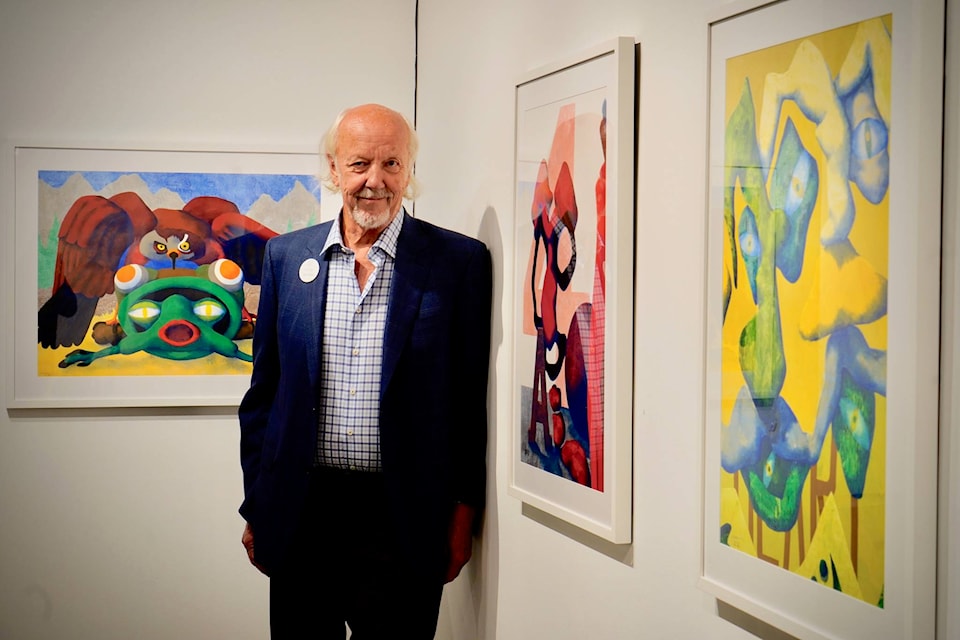For South Surrey painter and sculptor George Casprowitz, the ability to embrace change – and the freedom to explore new paths of creativity – has been a key element in his 50-year-plus career as an artist.
“Change is not a bad thing,” he said.
Impending change – in this case, his and his wife Kathleen’s choice to downsize from their house to a new condo near Peace Arch Hospital later this year – is the motivator for this month’s three-weekend show and sale of work spanning the 81-year-old painter and sculptor’s entire career, which has included solo shows in Toronto, New York, London, Seattle, Portland, Calgary, Victoria and Philadelphia.
“In many ways it’s a retrospective,” the U.S.-born former architect added, noting that pieces for sale represent virtually every phase of his career, from early architectural drawings, to abstracts and collages, to signature works employing solid colours and simple forms in intriguing juxtapositions.
He’s hoping that means there will be something of appeal to just about every kind of art buyer at the show, scheduled for three successive Sundays this month (April 11, 18 and 25), from noon to 3 p.m. , at 13563 23A Ave.
But rest assured it does not represent the end of his career – while he may not be tackling any more sculptural pieces, he’ll be transforming an extra bedroom in the new condo into a painting studio, he said.
“I’m going to keep on doing it until I’m in the casket,” he laughed.
A Peninsula resident for more than 50 years – since around the time of his first solo show at former Vancouver venue Gallery Allen – Casprowitz followed a relatively circuitous route into fine art.
He was born in Hollywood, Calif. during the glory years of the movie capital, and after graduating from John Burroughs High School in Burbank in 1958, it was only natural that he would gravitate to the film industry – then undergoing the last hurrahs of the old studio system – for his first full-time employment.
“It paid my way through college – going all the way from being a labourer and carpenter to being a scenic artist,” he said. “The last job there was in the art department (at Warner Bros.) during the making of My Fair Lady, in 1963.”
The classic musical, starring Rex Harrison and Audrey Hepburn, won an Academy Award for best art direction (colour) for supervisors Gene Allen, Cecil Beaton and George James Hopkins, and Casprowitz remembers the film as “a boon for colour in the movies.”
He acknowledges it’s a fair question whether this experience – early as it was – had an enduring influence on his art.
“I think it did, in a way,” he said. “It was an era in which colour was very important, and you were working in a square or rectangular format – you had to think of what the camera was ‘seeing’ and you always had to be thinking that everything travelled from the left to the right; good guys enter from the left, bad guys from the right, that sort of thing.
“Colour has been very important for me – it’s the consistent element all the way through my work,” he added. “I was an architect for a while, but I got out of it for the simple reason that colour wasn’t involved in any significant way. I felt the work was lacking one of my main talents.”
While Casprowitz has always been very sensitive to colour as one of the primary elements of visual art, he noted he hasn’t ever favoured one particular palette over another.
“I couldn’t say I had a red period or an ochre period. When I put down one colour I work from that – it’s an emotional reaction. When I’m working on building a painting I’m trying to react to what I’ve just painted. I don’t have a great plan from beginning to end. I might start with blue, but that doesn’t mean it will end up being a blue painting.”
Likewise architecture, which he practised in New York and Philadelphia after graduating with a master’s degree from the University of Oregon in 1965, has had an enduring effect on his work, Casprowitz said.
“My background as an architect taught me that form is very important, and that what you build from a few forms builds other spaces. Each stage is a reaction to what’s already there. You always judge good architecture on its placing of form, but even more on how that affects the things around it. You’re building a space, but you want it to be esthetically pleasing.”
Even when painting in ‘flat’ media, he’s always felt that his forms have an implied three-dimensionality to them, he said.
“It seemed like a natural thing to want to explore those forms as sculpture,” he said.
“And I always liked working in wood and working in clay – it was a comfort thing.”
While all his work seems to bear his individual stamp, he hasn’t been hesitant about exploring new media and techniques, Casprowitz said.
And he said he feels his intuitive, in-the-moment style of creating art has allowed him more freedom than artists who settle on one subject and style and repeat it with only minor variations for the rest of their lives.
“Even at my age, I’m always learning,” he said.
“I feel there’s youth in my work because I’m always learning, always growing.”
alex.browne@peacearchnews.com
Like us on Facebook and follow us on Twitter
